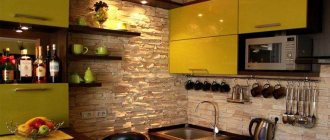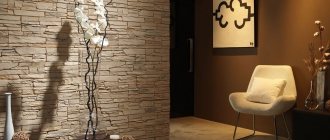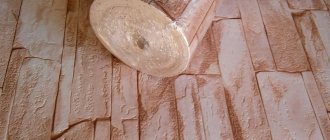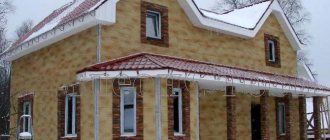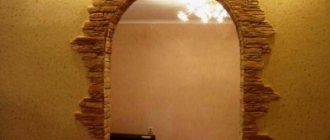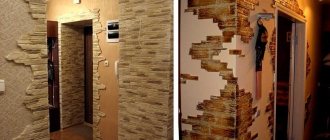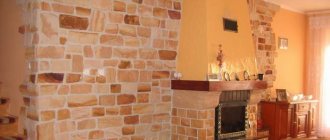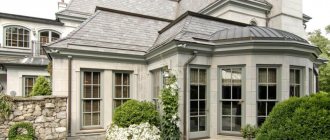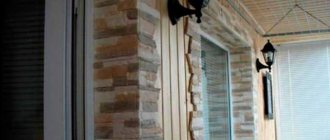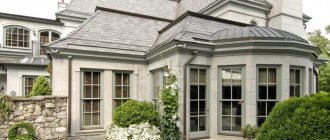A wide variety of finishing materials can be used to finish the slopes of a door or window opening. One of them is a door slope made of stone. This is a stylish design solution that gives the room a special mood depending on the type of artificial decorative stone.
There are several techniques for decorating slopes and the openings themselves - this can be a strict symmetrical finishing of the entire opening from the outside or partial: the edges can be torn, the masonry can extend to a fragment of the wall. In any case, finishing the slopes of the front door with decorative stone or window openings always looks modern and elegant.
Differences in artificial stone by material of manufacture
The artificial masonry used to finish door slopes does not differ in appearance from natural masonry. The composite is made on the basis of different materials, so it has three varieties.
| Material | Description |
| Gypsum | This is an environmentally friendly material, which is characterized by: • high sound insulation; • thermal insulation; • practicality; • strength; • various shades; • ease of installation. |
| The features of this material include the following: • special equipment is required for its production; • can be used not only for internal, but also for external cladding; • high moisture resistance; • the material does not absorb dust and dirt; • easy to clean, but the use of cleaning products with abrasive additives is not recommended; • when ignited, it only melts without releasing toxins dangerous to humans; • wear-resistant; • repairable. | |
| Consists of marble, granite and quartz chips with the addition of coloring pigments. This decorative material is characterized by: • the ability to be used in rooms with temperature changes and high humidity; • strength; • practicality; • moisture resistance; • costs less than acrylic stone. |
Choosing stone cladding for work
High-quality decorative stones of artificial origin are difficult to distinguish from similar natural materials with the same texture. However, natural stones differ in their pattern and texture, which are not repeated, and may contain various inclusions and foreign additives. But the strength of natural materials is much higher. This ensures the durability of the coating, which can last up to 150 years.
Artificial stones have advantages:
- Light weight, which greatly simplifies installation and lightens the entire masonry. In multi-storey buildings, these materials do not create a significant load on the supporting structures.
- The price of the material is lower than natural analogues with the same texture, installation will also be much cheaper.
- Due to the same size of all elements, the amount of waste and operations to adjust the shape and pattern is significantly lower.
- It can be used in different rooms, even for wall cladding in the bathroom, bathroom, kitchen and other rooms with extreme conditions: high humidity, temperature fluctuations, fat deposits, and other influences on the surface.
- Maintenance is very easy due to the dense surface, which allows you to use different detergents.
The disadvantages of artificial stone compared to natural stone are:
- less strength, durability;
- since scratches, chips, cracks as a result of mechanical damage appear more easily, repairs of artificial slabs will be carried out more often;
- gabbro, diorite and granite may have a small degree of radioactivity because they are of igneous origin.
Attention
Natural stones are heavier, which does not allow them to be used as cladding in multi-storey buildings.
Types of artificial stone depending on external design
Modern manufacturers offer the most common textures and shades of this artificial material. Below are samples of some of them.
| Alpine slate | Rock formation |
| Under the brick | Bassoon |
| Marbled | Granite |
| Rocky Pile | Old fortress |
Photos of arches made of decorative stone
Decorating a doorway with artificial stone is a great way to fill your interior with style and a feeling of comfort.
vote
Article rating
Types of masonry
There are two types of masonry - with and without seams. The seam looks better when laying elements of a clearly defined geometric shape.
Seam preservation
When performing finishing work from artificial stone, you can use a masonry technique that preserves the seams. In order for the seams to be even, it is necessary to install plastic wedges between them. This will keep the masonry elements in the required position while the adhesive solution sets.
To maintain the gap between the stones, plastic wedges are used
When finishing slopes with stone, work begins in the lower corner. Cover part of the wall with the adhesive solution using a comb spatula. The decorative element is applied to the wall and pressed.
Stone surface finishing technique
If the door slopes do not have a door leaf, then the decorative stone is laid overlapping. If there is a door, the color and texture of the openings should fit harmoniously into the interior and be combined with other decorative finishing materials.
Joining seams
The jointing occurs after the decorative material and the wall surface have completely set. The instructions from the manufacturer of the artificial stone contain recommendations on the use of the type of grouting composition.
Using a syringe gun, the seam is filled to a depth not exceeding 5 mm. This will give the masonry a more pronounced relief.
Seam cutting is done using a syringe gun.
When the grout begins to set, it must be leveled using a shaped spatula or spatula.
A spatula or spatula is used to grout the seam.
The remaining grout from the front surface can be cleaned off with a brush.
Clean seams with a brush
A stone door slope will look more solid if the grout color is gray. Light grout against the background of dark decorative masonry will refresh its overall perception.
Monolithic masonry
When designing a door slope without seams, the work takes less time. The monolithic nature of the masonry is achieved by placing the elements as closely as possible to each other. With this method, the adhesive solution is applied directly to the product .
In monolithic masonry, the elements are laid as close to each other as possible
It is important that there are no traces of glue left on the outside.
The adhesive solution is applied to the stone
When laying, it is necessary to control the vertical direction of the masonry. If the products have the correct geometric shape, then it is important to ensure their correct horizontal position.
Check the evenness of the masonry using a level
At the final stage, the masonry is coated with a solution that increases the strength and water-repellent characteristics of the material.
Useful tips
High quality finishing work begins with the purchase of high-quality material. In relation to gypsum-based artificial stone, this means the following:
- stone tiles are the same in size, i.e. they have a length, width and height that differ by no more than 1 - 2 mm;
- the stone material is homogeneous, does not have cavities and inclusions larger than 5 mm in each of three dimensions;
- The coloring of the stone is not done by surface spraying, but by introducing a dye into the composition while stirring.
Before installing the cladding on the wall, the future panels are laid out on the floor. This will allow you to see possible flaws in the arrangement of the stones and eliminate them before starting to work with the adhesive solution.
During finishing operations, safety regulations must be strictly observed. It’s not for nothing that at the dawn of the twentieth century a poster hung in Ford’s workshops: “God created man, but did not provide spare parts for him!” Even convinced atheists should remember this!
Finishing a window opening with artificial stone
Decorating windows with stone looks no less impressive than decorating doorways. An important condition is the size of the elements. It is necessary to trim the window slope with a small facing stone so that the finished window opening does not look massive.
It is recommended to use small products for window cladding
Window slopes must be leveled and primed outside and inside. When using artificial material, reinforcing the surface of the slope, even if it is made of plasterboard, using reinforced mesh is not required.
The material is laid on the windows using the monolithic method, starting from the bottom of the slope. When the lower fragments are securely fixed, you can continue laying out the upper rows. Corners should be formed by trimming the end sides of the facing products at an angle of 45 degrees.
Window cladding outside and inside - original solutions with an individual approach!
Cladding a window opening with natural stone is a complex process. Entrusted to specialists, it can result in excellent results. Experienced craftsmen of the SU-186 Construction Department will carefully consider the requirements of each Customer. The edge covering will be carried out after leveling the slopes, sealing cracks, crevices, eliminating defects and excess polyurethane foam.
Window cladding with stone, outside or inside, is done on plastered, smooth wall surfaces. Natural material is selected taking into account the bearing capacity of the foundations and operating conditions. Dagestan shell rock, travertine, sandstone are used for exterior work, marble, tuff, quartzite - for interior decoration. Window sills with a natural marble pattern will be especially decorative. They are made from several slabs and can take on any shape.
Design and engineering of building facades
When decorating walls, it is not at all necessary to cover the entire surface with stone. Design solutions in which only part of the surface is covered with stone, and the rest is covered with plaster, look very impressive.
Light and light plaster contrasts with the cold and dark stone cladding, creating an attractive design. Studying photos of stone façade decoration with different style solutions will help you choose a design and develop a project.
Upholstery of wooden doors
Users often search for videos about decorating a wooden front door with their own hands, inside and out. This process is called upholstery, the material for which is leather (natural or artificial), leatherette or polyvinyl chloride film. Those who want to save money use foam rubber as insulation, while adherents of high quality use isolon (a modern polymer). The insulation is tightly glued to the wooden door before the upholstery is covered with a decorative coating. The result is soft upholstery. For a hard one, you will need wood, veneer, laminate, MDF or plastic; insulation is not used.
Decorative finishing of internal walls using the example of laying gypsum tiles under brick
There are many positive aspects of this material:
- attractive appearance that will fit into almost any interior;
- ease of installation;
- environmental friendliness;
- durability.
The downside is that the cost is unfortunately not accessible to the general population.
You can lay gypsum tiles on the wall yourself, the main thing is to follow a number of recommendations:
- the wall should be plastered or puttied relatively evenly. For better adhesion, the working surface is treated with a deep penetration primer for interior work;
Wall prepared for laying tiles.
- gypsum tiles are purchased in the desired size and color, the main thing is to take them with a 5% margin. White tile adhesive is used for installation. It is diluted with water to such a state that the spatula “stands”, i.e. the consistency should be quite viscous and thick;
- since gypsum does not have particularly strong properties, you can use a hacksaw or a baguette saw to trim it;
- Wall finishing should start from the bottom up. Apply tile adhesive quite thickly to the tile using a small spatula, press it against the wall, and remove excess adhesive. Everyone chooses the width and size of the seams individually. It is better not to do the trimming right away, but leave it for the last stage of work (this will reduce material consumption). After installation, leave for a day or even more to dry completely, depending on the temperature in the room;
Adhesive for decorative gypsum tiles.
Glue ready for use.
Apply glue to the tiles.
We glue gypsum tiles to the wall.
Laying gypsum tiles - photo.
Wall decoration with gypsum tiles - photo.
- To finish the coating, you can use any façade varnish for stone. Its shade depends on the color of the tile. It can be colored or transparent. Apply the varnish to a dry surface using a regular brush in several layers. A minimum of a couple of hours should pass before applying the next coat. The seams should be treated especially carefully to hide defects, if any.
